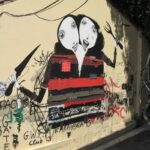 An exhibition of works that have been missing since World War II is the main attraction of a German museum – the Alte Nationalgalerie. One of the top attraction of the exhibition is a painting of the Florence skyline that hung in Hitler’s apartment in Berlin throughout World War II.
An exhibition of works that have been missing since World War II is the main attraction of a German museum – the Alte Nationalgalerie. One of the top attraction of the exhibition is a painting of the Florence skyline that hung in Hitler’s apartment in Berlin throughout World War II.
18 works returned to the Alte Nationalgalerie over the past decade, after half a century since they had been removed from their premises, are the core of this exhibition that peeks the interest of art and history lovers alike.
The exhibition also features documents that show the ordeal these works have gone through over years of improper storage in flak towers, salt mines and water-soaked cellars.
Although many of these works were in the possession of private parties, a recent international push for restitution has resulted in an increase in the number of works returned to the museum in the last decade.
“In recent years, attitudes have changed,” said Dorothea Kathmann, a legal expert with for the Prussian Culture Foundation. Efforts to track down and restitute art looted from Jewish collectors by the Nazis have helped encourage a broader focus on tracing pieces that were stolen or went missing during the Nazi era and World War II.
“Today not only the question of ownership is in focus, but attempts to trace Jewish collections, have brought an ethical and moral –even political – element” to research, Kathmann said.
By the end of the World War II, about 800 artworks that had been in the collection of the Alte Nationalgalerie had gone missing. Two-thirds of them were recovered by the end of the 1950s. In the last 20 years more than two dozen artworks have been also returned.
Berlin’s reunification and other political developments along the use of the Internet helped circulate databases and have made it easier to spread the word about missing artworks, leading to a jump in the number of returns since 2000, said Berlin Museum director Michael Eissenhauer.
Wilhelm Ahlborn’s “A View of Florence” is one of 68 works loaned by the gallery to the Nazi regime and hung in Hitler’s private quarters at his chancellery. Earlier this year, the painting turned up in a Berlin art gallery, which in turn alerted the museum.
Kathmann said that in most cases, ownership is proven, a “finder’s fee” for the current owners, worth roughly 10% of the picture’s market value, has been negotiated.
“From our point of view, we do not see a need to pay for the works a second time,” Kathmann said.
“Dog with Gray Horse” by English painter William Cole, was reacquired by the museum in October. It had been hung by Nazi officials in a Berlin villa which was housing the then exiled Iraqi prime minister between 1942 and 1945.
The painting has been given as payment to the housekeeper at that time. A descendant of the housekeeper contacted the museum – reflecting what Eissenhauer called a generation change that is benefiting the museum.
“Many paintings are changing hands and the younger generation is starting to ask where they come from,” Eissenhauer said. “We are hoping that the curve will continue to go up.”

 By
By 








